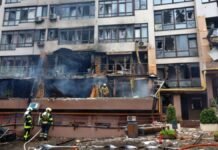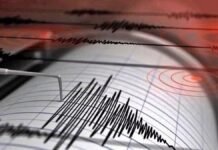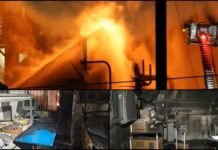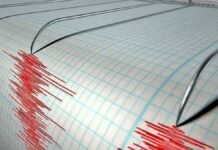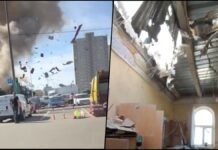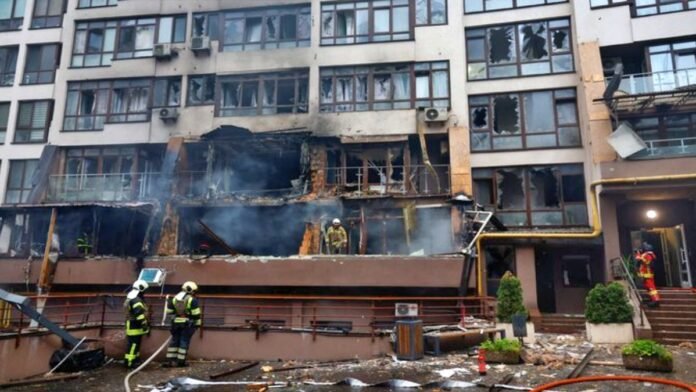
Key Points
- Major Russian drone and missile attack on Kyiv Friday morning sets residential buildings ablaze
- Nine people injured, five hospitalized following strikes on capital city
- Multiple power stations hit causing blackouts along eastern Dnipro River areas
- Energy Minister Svitlana Grinchuk confirms deliberate targeting of Kyiv’s energy facilities
- High-rise residential building in Pechersky district suffers fire on sixth and seventh floors
- Zaporizhzhia in southeast Ukraine also struck, injuring three civilians
- Russia systematically attacking Ukraine’s energy infrastructure ahead of winter season
- Recent strikes damaged key gas production facilities across Ukraine
- President Zelensky warns Moscow creating psychological pressure through energy and railway targeting
- Ukraine retaliates with drone strikes on Russian power stations and infrastructure
- Fuel prices rising in Russia due to Ukrainian counterattacks
- Toxic gas leak reported after pipeline rupture in disputed territory
Kyiv: A devastating Russian assault on Kyiv during the early hours of Friday morning has once again brought the brutal reality of the ongoing Russia-Ukraine conflict to the forefront, as coordinated drone and missile strikes targeted critical energy infrastructure and residential areas across Ukraine’s capital city. The attack, which represents one of the most significant assaults on Kyiv in recent weeks, caused widespread damage, injuries, and power disruptions as the nation braces for the approaching winter season.
Casualties and Immediate Impact
Kyiv Mayor Vitaly Klychko confirmed that nine civilians sustained injuries in the Friday morning attack, with five individuals requiring immediate hospitalization due to the severity of their wounds. The injured were transported to medical facilities across the capital for emergency treatment, though authorities have not disclosed the full extent of their conditions or whether any remain in critical.
The strikes caused significant infrastructure damage throughout the capital, with particular devastation along the eastern bank of the Dnipro River. Multiple neighborhoods in this area experienced complete power outages as Russian forces successfully struck several electricity substations and power distribution facilities. Energy workers scrambled to restore services while firefighters battled blazes ignited by the attacks.
Residential Buildings Under Fire
The assault targeted both military and civilian infrastructure, with several apartment complexes suffering direct hits. Dramatic images circulating on social media platforms showed firefighters desperately working to extinguish flames engulfing residential buildings while terrified residents evacuated to safety. The scene painted a grim picture of the ongoing humanitarian toll of the conflict.
A high-rise residential building in Kyiv’s Pechersky district bore the brunt of the attack, with fires breaking out on the sixth and seventh floors following a direct drone strike. Residents described hearing explosions followed by the sound of shattering glass and the acrid smell of smoke as flames rapidly spread through the building. Emergency services responded swiftly, but the psychological trauma inflicted on civilians continues to mount.
Throughout various parts of the city, the charred remains of downed drones littered streets and rooftops, serving as stark reminders of the aerial assault. Ukrainian air defense systems managed to intercept numerous incoming threats, but several penetrated the defensive umbrella, causing the observed destruction.
Strategic Targeting of Energy Infrastructure
Energy Minister Svitlana Grinchuk issued a statement confirming that Russian forces had deliberately targeted Kyiv’s energy facilities in a calculated assault designed to cripple the capital’s power supply. In a Facebook post, she assured citizens that energy sector specialists were implementing all necessary emergency measures to mitigate the negative impacts of the attacks and restore services as quickly as possible.
The targeting of energy infrastructure represents a systematic Russian strategy that has intensified in recent weeks. With winter rapidly approaching and temperatures beginning to drop, disrupting Ukraine’s ability to generate and distribute electricity and heating threatens to create a humanitarian crisis affecting millions of civilians.
Timur Tkachenko, head of Kyiv’s military administration, provided additional details about the nature of the assault, confirming that Russian forces employed a combination of drones and missiles in the late-night and early morning attacks on the capital. This multi-pronged approach challenges Ukrainian air defense systems by forcing them to track and intercept diverse threats simultaneously.
Wider Pattern of Infrastructure Attacks
The Friday morning assault on Kyiv forms part of a broader Russian campaign systematically targeting Ukraine’s energy system across multiple regions. In recent weeks, Moscow has intensified strikes specifically aimed at crippling energy production, transmission, and distribution capabilities as the three-and-a-half-year conflict continues.
Major missile and drone strikes conducted last week successfully hit several key gas production facilities throughout Ukraine, significantly impacting the nation’s ability to extract and process natural gas resources. These attacks threaten Ukraine’s energy independence and its capacity to maintain adequate fuel supplies during the critical winter months when heating demands spike dramatically.
Attacks Beyond Kyiv
The Russian assault extended beyond the capital, with the southeastern city of Zaporizhzhia also suffering significant strikes. According to the local governor, Russian drones struck multiple targets throughout the city, injuring at least three civilians and igniting fires in residential areas. At minimum one apartment building caught fire, forcing residents to flee while emergency services battled the flames.
Zaporizhzhia, located in southeastern Ukraine, holds strategic importance due to its proximity to the front lines and the presence of Europe’s largest nuclear power plant in the surrounding region. Continued attacks on this area raise international concerns about potential impacts on nuclear safety and regional stability.
President Zelensky’s Assessment
Ukrainian President Volodymyr Zelensky addressed the escalating attacks during a Thursday statement, characterizing Russia’s strategy as deliberate attempts to sow chaos, create widespread psychological pressure among Ukrainian civilians, and undermine national morale. He specifically highlighted Moscow’s targeting of energy centers, electrical substations, and railway infrastructure as components of this calculated campaign.
Zelensky emphasized that Ukraine’s gas supplies have already come under severe pressure due to persistent Russian attacks throughout the current year. The cumulative damage to production facilities, storage sites, and distribution networks has significantly reduced Ukraine’s energy security and self-sufficiency.
The president warned that if Russian strikes continue at their current intensity and effectiveness, Ukraine may face no alternative but to substantially increase gas imports from international suppliers to meet domestic demand during winter. This dependence on imports creates additional economic burdens and potential vulnerabilities if supply chains become disrupted.
Ukraine’s Retaliatory Campaign
While enduring these devastating attacks, Ukraine has simultaneously escalated its own drone and missile strikes targeting infrastructure within Russian territory. President Zelensky indicated that this counteroffensive strategy is producing tangible results, with fuel prices rising noticeably across Russia due to attacks on refineries and energy facilities.
Ukrainian forces successfully struck a power station in Russia’s Belgorod region, causing widespread blackouts and demonstrating Kyiv’s growing capability to project force across the border. These retaliatory strikes serve multiple purposes including degrading Russian military logistics, imposing economic costs, and demonstrating that Ukraine possesses the will and capability to respond to aggression.
On Thursday, Russian authorities accused Ukraine of damaging a pipeline previously utilized to transport ammonia gas to other countries. The alleged attack ruptured the pipeline, causing a leak of toxic gas that poses environmental and health hazards to surrounding areas. Russia claims the strike represents an escalation targeting civilian infrastructure, though Ukraine has not officially confirmed responsibility.
Winter Strategy and Humanitarian Concerns
The timing of Russia’s intensified energy infrastructure attacks carries grave humanitarian implications. As temperatures decline and winter approaches, Ukrainian civilians depend heavily on reliable electricity and natural gas supplies for heating, cooking, and basic survival needs. Systematic destruction of energy facilities threatens to create conditions where millions of people face exposure to harsh winter conditions without adequate heating or power.
International humanitarian organizations have expressed alarm about the potential consequences of prolonged energy disruptions during winter months. Previous winters during the conflict have seen civilians enduring temperatures well below freezing in damaged or destroyed homes with limited access to heating, leading to health crises and increased mortality particularly among vulnerable populations including the elderly and children.
International Response and Ongoing Conflict
The latest attacks underscore the enduring brutality of the Russia-Ukraine conflict as it approaches its fourth year with no clear path to resolution. International observers continue documenting potential war crimes including deliberate targeting of civilian infrastructure, though enforcement mechanisms remain limited.
Western nations supporting Ukraine have pledged additional air defense systems and energy infrastructure repair equipment to help mitigate the impacts of these attacks. However, the scale of destruction continues to outpace repair efforts, creating cumulative degradation of Ukraine’s essential services.
As both sides intensify their respective campaigns targeting infrastructure deep within enemy territory, the conflict shows no signs of de-escalation. The combination of military operations, energy warfare, and psychological pressure campaigns suggests a protracted struggle with devastating consequences for civilian populations on both sides of the border.
The coming winter months will likely prove critical in determining whether Ukraine can maintain essential services for its population while sustaining military operations against Russian forces. The international community watches anxiously as this humanitarian and strategic situation continues to unfold with global implications for energy security, regional stability, and international law.







